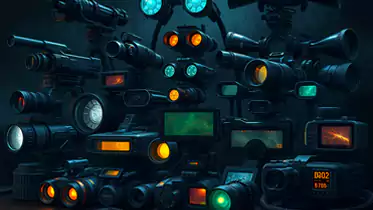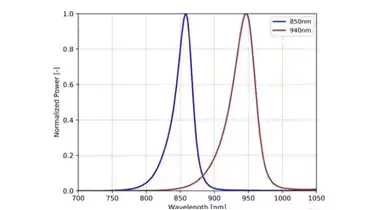In Security Industry: The Application of Night Vision and Thermal Imaging

In modern society, safety protection is no longer just a concept, but an important aspect that must be considered in the daily operation of enterprises, communities, and even all public places. With the increasing demand for security, related technology is also constantly advancing, and the application of night vision and thermal imaging technology is becoming more and more common. These two technologies provide 24/7 monitoring capabilities for security systems, especially in low light or complex environments, which can perform exceptionally well.
Night Vision and Thermal Imaging Technology
Night Vision
The principle of night vision technology is simple, but it is very practical: it can amplify weak light, making environments that are invisible to the human eye clear and visible. Or seeing the target through infrared illumination in complete darkness. In the past, such devices were mostly used for military purposes, but now with the maturity of technology and cost reduction, more and more enterprises and property management companies are adopting them, and night vision devices are increasingly being applied in the daily lives of ordinary people. Modern night vision devices can not only clearly recognize target contours in near total darkness, but also use infrared fill light to make completely dark environments no longer “invisible”. This ability is particularly important for night patrols, intrusion prevention, and other scenarios, as it can greatly enhance the sense of security.

Thermal Imaging
In contrast, thermal imaging technology is even more “magical”. Thermal imagers actually do not rely on light, but generate images by capturing the infrared differences in the heat emitted by objects. Whether it’s thick fog, smoke, or pitch black nights, thermal imagers can accurately display the contours and movements of objects. For example, intruders lurking in buildings can be detected by temperature monitoring systems even if they are completely invisible. Therefore, thermal imaging devices play an irreplaceable role in high security requirements such as important facilities, warehouses, and border patrols.The Use of Night Vision and Thermal Imaging
In fact, many security systems combine night vision and thermal imaging technologies to complement each other’s advantages. Night vision provides stronger image clarity and detail recognition ability during the day or in well lit nights; In low light or complex environments, thermal imaging technology can ensure uninterrupted monitoring. The integration and installation of this technology in the instrument enables security personnel to respond more quickly to abnormal situations through mode switching. In this way, not only is 24/7 monitoring possible, but the false alarm rate is also greatly reduced. Managers can receive more reliable data support, and the efficiency of user experience and security can be greatly improved.

The advancement of technology has made the applications of night vision and thermal imaging more diverse. For example, outdoor wide area monitoring may require high magnification thermal imaging lenses to achieve target recognition of hundreds or even thousands of meters; In contrast, some security patrol personnel need to use portable night vision devices to freely deploy and control in order to make quick responses and improve work efficiency. Even combined with AI image analysis, the system can automatically identify abnormal behavior, track personnel movements, generate historical records, and provide scientific basis for safety management. This intelligent management makes security no longer just passive protection, but a powerful tool for proactive warning and risk control.
From the perspective of business managers, night vision technology and thermal imaging technology can also be used for risk prevention and control. For example, thermal imaging can be used to monitor the temperature of key equipment, which can detect fire hazards or equipment abnormalities in advance; Night vision monitoring can record suspicious behaviors at night and provide clues for post investigation. This combination of two technologies in a security system can not only protect property safety, but also help managers timely grasp potential risks, making security management more forward-looking.How to Choose the Right Product?
When choosing a device, we need to consider performance indicators such as resolution, zoom factor, response speed, and environmental adaptability. High quality equipment usually has waterproof, dustproof, and impact resistant designs, which can ensure the long-term stable operation of the instrument in outdoor or harsh conditions. At the same time, the manufacturer’s after-sales service and technical support are also very important, which directly affects whether the equipment can solve problems in a timely manner during operation. The effectiveness of security systems depends not only on the equipment itself, but also on the improvement of product supporting services and management solutions.

Night vision and thermal imaging technology have become an indispensable part of modern security systems. By combining the two, not only has the monitoring capability been improved at night and in complex environments, but it also provides strong support for intelligent management. With the continuous advancement of technology, future security systems will become more intelligent, efficient, and reliable, providing more stable protection for both public safety and enterprise assets. It can be said that night vision and thermal imaging technologies are making security more secure and reliable in a more visible and tangible way.





